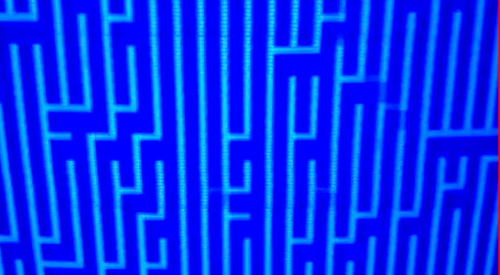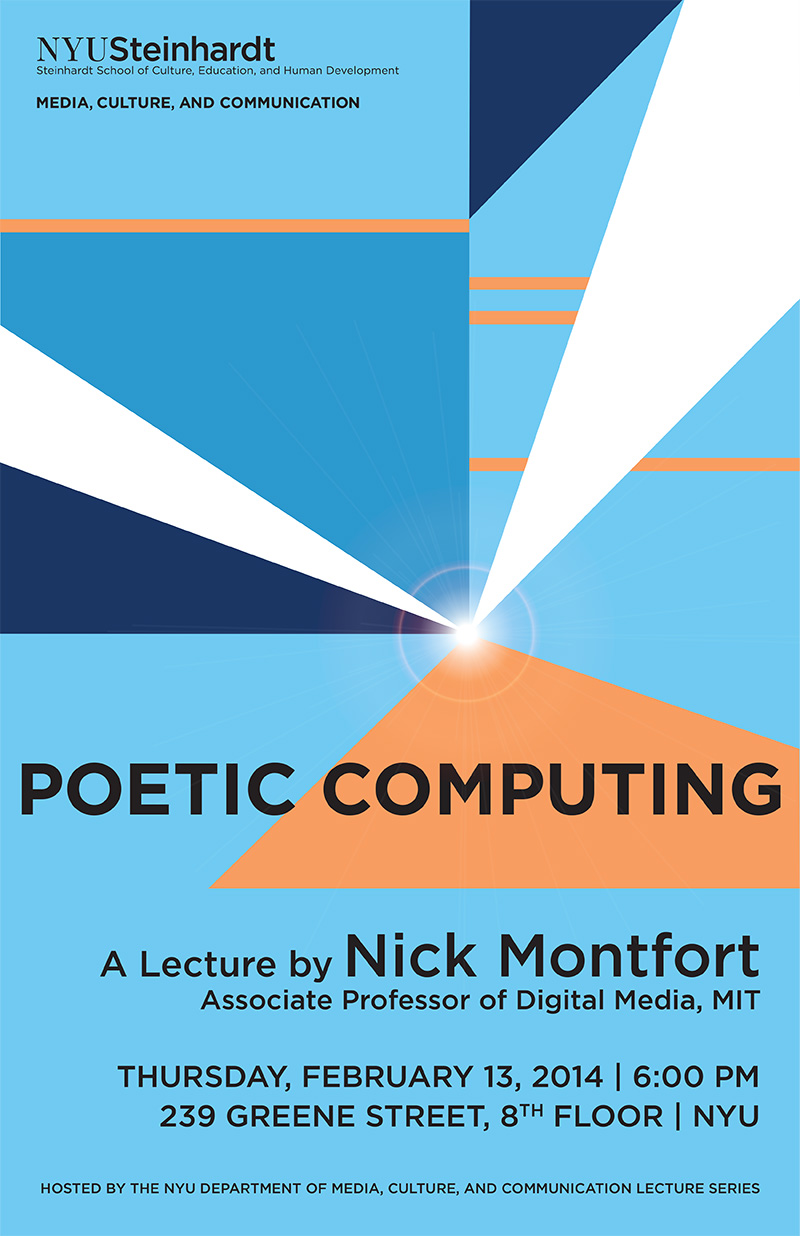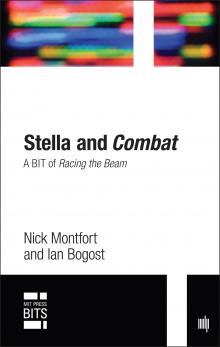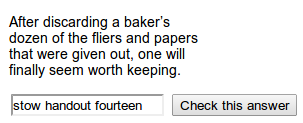Here’s the Boston.com article on our exhibit “Programs at an Exhibition,” which opens Thursday (March 6). Hope to see you at the opening, which is 6pm-9pm.
Get Yer Consumer Survey Here
I like clicking through this: “Psychographics: Consumer Survey” by Dane Watkins. And I learned something about myself by doing so. I think. Yes.
10 PRINT Gets 10 SUNG
Or at least inspires a song and video…
The musical group Bedford Level Experiment writes of their song “Confounded to Corruption” and of the video for it:
>We’ve been reading the book 10 PRINT CHR$(205.5+RND(1)); : GOTO 10 and became very inspired by the section on procedurally generated art. All the footage in this video was generated by Commodore 64 programs written by us, including a 6502 assembly version of 10 PRINT. The lyrics were also generated algorithmically; Sonnet 64 and some commentary on it from Wikipedia were fed into an old Amiga program called NIALL, and the output was edited together into something resembling lyrics. The corruption the sonnet underwent became the theme of the song and video.
The line of verse the lyrics are based on,
>Or state itself confounded to decay
is, quite aptly, line 10 of Shakespeare’s sonnet 64.
“Programs at an Exhibition” March 6-16
Nick Montfort & Páll Thayer
Programs at an Exhibition
At the Boston Cyberarts Gallery
141 Green Street, Jamaica Plain, MA 02130
Located in the Green Street T Station on the Orange Line
Phone number: 617-522-6710
The exhibit runs March 6 through March 16.
Opening: 6pm-9pm, Thursday March 6.
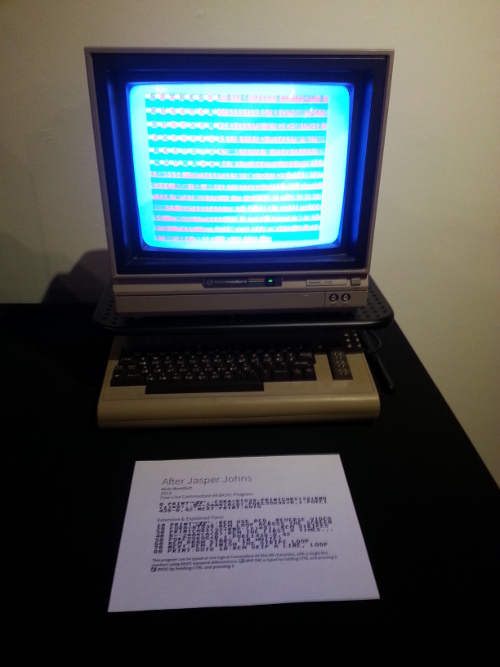
Part of the life of remarkable artworks is that they are appropriated, transformed, and made new. In Programs at an Exhibition, two artists who use code and computation as their medium continue the sort of work others have done by representing visual art as music, by recreating performance pieces in Second Life, and by painting a mustache and goatee on a reproduction of the Mona Lisa. Programs at an Exhibition presents computer programs, written in Perl and Commodore 64 BASIC, each running on its own dedicated computer. The 20th century artworks reenvisioned in these programs include some by painters and visual artists, but also include performances by Joseph Beuys and Vito Acconci. All of the underlying code is made available for gallery visitors to read; they are even welcome to take it home, type it in, and run or rework these programs themselves.
The programs (Commodore 64 BASIC by Nick Montfort, Perl by Páll Thayer) re-create aspects of the concepts and artistic processes that underlie well-known artworks, not just the visual appearance of those works. They participate in popular and “recreational” programming traditions of the sort that people have read about in magazines of the 1970s and 1980s, including Creative Computing. Programmers working in these traditions share code, and they also share an admiration for beautiful output. By celebrating such practices, the exhibit relates to the history of art as well as to the ideals of free software and to the productions of the demoscene. By encouraging gallery visitors to explore programming in the context of contemporary art and the work of specific artists, the exhibit offers a way to make connections between well-known art history and the vibrant, but less widely-known, creative programming practices that have been taken up in recent decades by popular computer users, professional programmers, and artists.
The Perl programs in the exhibit are from Microcodes, a series of very small code-based artworks that Páll Thayer began in 2009. Each one is a fully contained work of art. The conceptual meaning of each piece is revealed through the combination of the title, the code and the results of running them on a computer. Many contemporary programmers view Perl as a “dated” language that saw its heyday in the early ages of the World Wide Web as the primary language used to combine websites with databases. Perl was originally developed by Larry Wall, whose primary interest was to develop a language for parsing text. Because of his background in linguistics, he also wanted the language to have a certain degree of flexibility which has contributed to its motto, “There’s more than one way to do it.” “That motto, ‘TMTOWTDI,’ makes Perl challenging for professional programers who have to take over other’s people code and may struggle to make sense of it,” Thayer said. “But it’s one of the main reasons that Perl, a very expressive programming language, appealed to me in developing this project. This flexibility encouraged Perl programmers to explore individual creative expression in the writing of functional code.”
“Páll’s work in Microcodes engages explicitly with the way computer programs are read by people and hwo they have meanings to those trying to understand them, modify them, debug them, and develop them further,” Nick Montfort said. “The Perl programs in Microcodes are quite readerly when compared to my BASIC programs. I’ve tried to engage with a related, but different documented historical tradition — the one-line BASIC program — as it works in a particular computer, the Commodore 64, and to dive into what that particular computer can do using a very limited amount of code, given these many formal, material, and historical specifics. Because my programs are harder to understand, even though they are written in a more populist programming language, I’m including versions of the program that I have rewritten in a clearer form and that include comments.” Montfort’s related projects include a collaborative book, written with nine others in a single voice, that focuses on a particular Commodore 64 BASIC one-liner. The book, published in 2012, is named after the program that is its focus, 10 PRINT CHR$(205.5+RND(1)); : GOTO 10. Montfort also writes short programs to generate poetry. These include two collections of Perl programs that are constrained in size: his ppg256 series of 256-character programs, and a set of 32-character concrete poetry generators, Concrete Perl. His book #! (pronounced “Shebang”) collects these and other poetry generators, along with their output, and is forthcoming from Counterpath Press.
Nick Montfort develops literary generators and other computational art and poetry, and has participated in dozens of collaborations. He is associate professor of digital media at MIT and faculty advisor for the Electronic Literature Organization, whose Electronic Literature Collection Volume 1 he co-edited. Montfort wrote the book of poems Riddle & Bind and co-wrote 2002: A Palindrome Story with William Gillespie. The MIT Press has published four of Montfort’s collaborative and individually-authored books: The New Media Reader (co-edited with Noah Wardrip-Fruin), Twisty Little Passages, Racing the Beam (co-authored with Ian Bogost), and most recently 10 PRINT CHR$(205.5+RND(1)); : GOTO 10, a collaboration with Patsy Baudoin, John Bell, Ian Bogost, Jeremy Douglass, Mark C. Marino, Michael Mateas, Casey Reas, Mark Sample, and Noah Vawter that Montfort organized. Nick Montfort’s site, with his digital poems and a link to a free PDF of 10 PRINT: http://nickm.com
Páll Thayer is an Icelandic/American artist working primarily with computers and the Internet. He is a devout follower of open-source culture. His work is developed using open-source tools and source code for his projects is released under a GPL license. His work has been exhibited at galleries and festivals around the world with solo shows in Iceland, Sweden, and New York and notable group shows in the US, Canada, Finland, Germany, and Brazil. Páll Thayer has an MFA degree in visual arts from Concordia University in Montréal. He is an active member of Lorna, Iceland’s only organization devoted to electronic arts. He is also an alumni member of The Institute for Everyday Life, Concordia/Hexagram, Montréal. Páll Thayer currently works as a lecturer and technical support specialist at SUNY Purchase College, New York. Páll Thayer’s Microcodes site: http://pallthayer.dyndns.org/microcodes/
Ten programs will be exhibited, running on ten computers. Two of them, one in Perl by Páll Thayer and one in Commodore 64 BASIC by Nick Montfort, are based on the same artwork, Jasper Johns’s Flag:
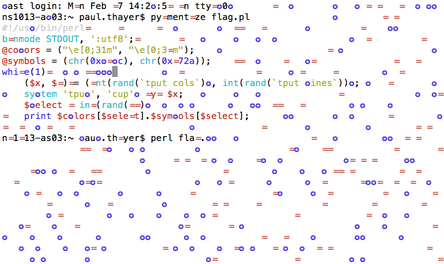
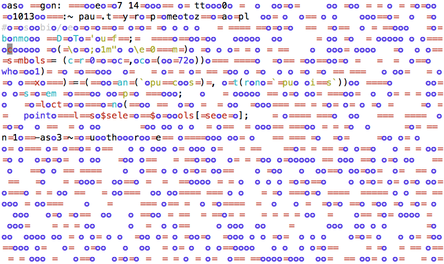
Flag · Páll Thayer
Perl program · 2009
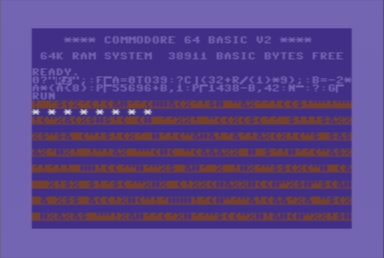
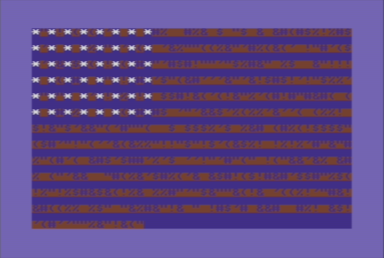
After Jasper Johns · Nick Montfort
one-line Commodore 64 BASIC program · 2013
Can I Use Your (CC-Licensed) Work?
Or free software work?
In ways that you have already explicitly allowed me to use it, in a legal document that you posted along with this work?
“POET The Game” The Movie The Poem…
It’s not quite Thy Dungeonman, but you can now play POET The Game, which pokes at the life of an MFA student poet in a browser-based roll-your-own-parser experience that is meant to recall the text adventures of yore.
The C64 in the NYT
My colleague Myke pointed out this New York Times column about the Commodore 64, which waxes nostalgic and also points out how the computer opened up possibilities for new programmers to explore and learn. Myke also pointed out, quite aptly, that the photo, which is supposed to be of a Commodore 64, is actually of a 1541 disk drive. Alas, the Grey Lady, in reference to the rainbow-logoed computer, nods…
“Programs at an Exhibition” Opens March 6
I’ll post more on this soon, but for now, let me invite you to the opening of my & Páll Thayer’s show at the Boston Cyberarts Gallery: 141 Green Street, Jamaica Plain, MA 02130, located in the Green Street T Station on the Orange Line, 617-522-6710.
The opening is 6pm-9pm on Thursday March 6.
The exhibit (which will be up March 6-16) will feature ten programs (five in Commodore 64 BASIC by Nick Montfort, five in Perl by Páll Thayer), each running on its own computer. The programs re-create aspects of the concepts and artistic processes that underlie well-known artworks, not just the visual appearance of those works. They participate in popular and “recreational” programming traditions of the sort that people read about in magazines of the 1970s and 1980s, including _Creative Computing._ Programmers working in these traditions share code, and they also share an admiration for beautiful output. By celebrating such practices, the exhibit relates to the history of art as well as to the ideals of free software and to the productions of the demoscene. By encouraging gallery visitors to explore programming in the context of contemporary art and the work of specific artists, the exhibit offers a way to make connections between well-known art history and the vibrant, but less widely-known, creative programming practices that have been taken up in recent decades by popular computer users, professional programmers, and artists.


Flag · Páll Thayer
Perl program · 2009


After Jasper Johns · Nick Montfort
one-line Commodore 64 BASIC program · 2013
xkcd’s Answer to World Clock
 … is today’s comic.
… is today’s comic.
And it’s true, Randall probably did not know about _World Clock_ (book, code). Maybe he didn’t even know about my inspirations, Harry Mathews’s “The Chronogram for 1998” or Stanislaw Lem’s _One Human Minute._
In that case it’s an unwitting answer.
In any case, it’s a nice one.
Intelligent Narrative Technologies 7 Seeks Submissions
Intelligent Narrative Technologies 7 will be co-located with the ELO 2014 conference and will take place June 17-18, 2014 in Milwaukee, WI.
>The Intelligent Narrative Technologies (INT) workshop series aims to advance research in artificial intelligence for the computational understanding, expression, and creation of narrative. Previous installments of this workshop have brought together a multidisciplinary group of researchers such as computer scientists, psychologists, narrative theorists, media theorists, artists, and members of the interactive entertainment industry. From this broad expertise, the INT series focuses on computational systems to represent, reason about, adapt, author, and perform interactive and non-interactive narrative experiences.
The (int)7 Call for Papers is online now, and the submission deadline is this March 3.
Purple Blurb’s Digital Writing Events this Semester
Purple Blurb, MIT’s digital writing series organized by Prof. Nick Montfort of the Trope Tank, powers on, thanks to the four excellent writers/artists who will be presenting in Spring 2014. All events this semester will be held Mondays at 5:30pm in MIT’s room 14E-310.
March 10, 5:30pm in 14E-310:
Páll Thayer
Microcodes
Short Perl programs that are also artworks, presented for viewers to read, download, and execute. Thayer will trace some key steps showing how he went from his background in painting and drawing to presenting code as his artwork.
Páll Thayer is an Icelandic artist working primarily with computers and the Internet. He is devout follower of open-source culture. His work is developed using open-source tools and source-code for his projects is always released under a GPL license. His work has been exhibited at galleries and festivals around the world with solo shows in Iceland, Sweden and New York and notable group shows in the US, Canada, Finland, Germany and Brazil (to name but a few). Pall Thayer has an MFA degree in visual arts from Concordia University in Montreal. He is an active member of Lorna, Iceland’s only organization devoted to electronic arts. He is also an alumni member of The Institute for Everyday Life, Concordia/Hexagram, Montreal. Pall Thayer currently works as a lecturer and technical support specialist at SUNY Purchase College, New York.
April 7, 5:30pm in 14E-310:
Lance Olsen
Experimental writing & video
Including a reading from his recent book _[[ there. ]]_ and video from his _Theories of Forgetting_ project.
Lance Olsen is author of more than 20 books of and about innovative writing, including two appearing this spring: the novel based on Robert Smithson’s earthwork the _Spiral Jetty, Theories of Forgetting_ (accompanied by a short experimental film made by one of its characters), and _[[ there. ]],_ a trash-diary meditation on the confluence of travel, curiosity, and experimental writing practices. His short stories, essays, and reviews have appeared in hundreds of journals and anthologies. A Guggenheim, Berlin Prize, N.E.A. Fellowship, and Pushcart Prize recipient, as well as a Fulbright Scholar, he teaches experimental theory and practice at the University of Utah.
April 28, 5:30pm in 14E-310:
Scott Rettberg
Videos & combinatory videos
Produced in collaboration with Roderick Coover, Nick Montfort, and others, including: _The Last Volcano, Cats and Rats, Three Rails Live and Toxicity._
Scott Rettberg is Professor of Digital Culture in the department of Linguistic, Literary, and Aesthetic studies at the University of Bergen, Norway. Rettberg is the project leader of ELMCIP (Electronic Literature as a Model of Creativity and Innovation in Practice), a HERA-funded collaborative research project, and a founder of the Electronic Literature Organization. Rettberg is the author or coauthor of novel-length works of electronic literature, combinatory poetry, and films including _The Unknown, Kind of Blue, Implementation, Frequency, Three Rails Live, Toxicity_ and others. His creative work has been exhibited online and at art venues including the Chemical Heritage Foundation Museum, Palazzo dell Arti Napoli, Beall Center, the Slought Foundation, The Krannert Art Museum, and elsewhere.
May 5, 5:30pm in 14E-310:
Jill Walker Rettberg
Selfies
With examples from her own work as well as from photobooths, older self-portraits, and entries from others’ diaries, in her talk “Seeing Ourselves Through Technology: How We Use Selfies, Blogs and Wearable Devices to Understand Ourselves.”
Jill Walker Rettberg is Professor of Digital Culture at the University of Bergen in Norway. Her research centers on how we tell stories online, and she has published on electronic literature, digital art, blogging, games and selfies. She has written a research blog, jilltxt.net, since October 2000, and co-wrote the first academic paper on blogs in 2002. Her book _Blogging_ was published in a second edition in 2014. In 2008 she co-edited an anthology of scholarly articles on _World of Warcraft._ Jill is currently writing a book on technologically mediated self-representations, from blogs and selfies to automated diaries and visualisations of data from wearable devices.
A Catalog of Trope Tank Warez
Thanks to RA Erik Stayton, we now have a formidable catalog of hardware and software in The Trope Tank, my lab at MIT.
There are pages on each of the systems (or in one case a group of switched systems) that are regularly hooked up and ready to use:
– Apple IIc System
– Atari 400 System
– Atari VCS System
– Commodore 64 System
– Macintosh SE System
– PowerMac G4 System
– Video Game Systems
Also, information is recorded about each display and about all the other working computers that are kept in the lab.
And while every last disk in the lab has not been cataloged, the VCS, Commodore 64, NES, Intellivision, and Odyssey cartridges and all packaged retail software on disk or CD-ROM are now listed in the extensive software catalog. For now, this catalog is presented as a simple, long Web page.
In other Trope Tank news, thanks to Jason Scott I’ve replaced a part in the Asteroids machine and the display no longer oscillates – the machine works perfectly.
The Trope Tank welcomes small classes, researchers, and artists and writers who are looking into the material properties of digital media. Please contact me if the lab’s resources can be of help to you. This Friday, while I will be out of town, Erik and Piotr Marecki (and a Commodore 64 system they are bringing) will be representing the lab at the MIT Museum and offering the public a view of how accessible and creative programming was in the early 1980s.
“Poetic Computing,” my Talk at NYU Thursday
Update: Blankets of snow and torrents of sleet have tried to match the intensity of the poster design below. As a result, today’s talk (2/13) is cancelled! NYU is closing at 3pm today. Hopefully there will be another chance before too long…
I don’t always announce my upcoming talks on my blog…
But when I do, they’re promoted by very nice posters.
BITS Are Now Flipped On
MIT Press has just launched the BITS series of excerpts from the press’s book publications. They are offered as DRM-free e-books, and come with a 40% discount on the purchase of the entire print or e-book from which the excerpt comes. I’m glad to see a collaborator and a colleague topping the list, and I’m also pleased that one of the first selections featured is from my and Ian Bogost’s Racing the Beam.
New E-Lit Authors Welcomed to ELO 2014
Those who have recently started developing electronic literature are welcomed to apply to have work in the Gallery of E-Literature First Encounters. Feb 15 is the deadline; the gallery will be at the “Hold the Light” conference, ELO 2014, in Milwaukee.
A Riddle
Consider it not in French, but Italian.
There are obsession-inducing transmissions, audio transmissions.
The ending is ugly … overall and in one language, at least.
But the story is a poet’s story – it begins with _O_ and ends with _O_.
“Description,” My 2014 New Year’s Poem
“Description,” my 2014 New Year’s poem, was sent out as a text file at the end of 2013; it’s now online in a solvable and checkable form, in a new Web edition.


